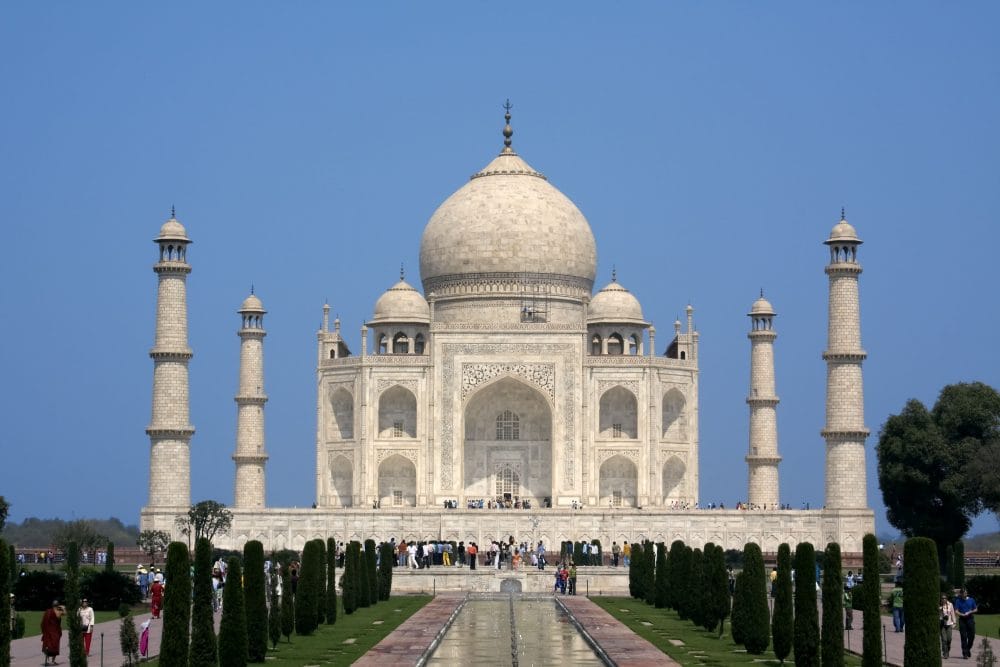
The changing face of the Taj Mahal
One of the most visible effects of India’s rapidly escalating pollution crisis is the changing face of one of its most iconic landmarks.
The Taj Mahal, a marble mausoleum which stands 240 feet tall on the banks of Yamuna river in Agra, is famous for its ivory white complexion. However, in recent years pollution has discoloured the building. According to a petition filed in the Supreme Court, “yellow pallor pervades the entire monument. In places the yellow hue is magnified by ugly brown and black spots.”
The Taj Mahal is far from the only casualty of air pollution in India. The death toll from pollution in the country is the highest in the world. There were 2.51 million fatalities in 2015.
The fourteen most polluted cities in the world are in India
Spotlighting the crisis again is new World Health Organization (WHO) data, which reveal that fourteen of the world’s fifteen most polluted cities are in India. In fact, Indian cities exclusively make up the first fourteen entries.
Kanpur, in Uttar Pradesh, is at the top of the list. It has the world’s highest atmospheric concentration of PM2.5 , at 173 micrograms per cubic metre. Faridabad takes second place on the list. Varanasi comes in third.
India does not fare much better in lists based on PM10 pollution. Delhi is the world’s most polluted megacity in this regard, with Mumbai (India’s most populous city) in fourth place. Delhi also places sixth on the list of most polluted cities in terms of PM2.5 pollution.
PM10 refers to coarse particles with a diameter between 2.5 and 10 micrometres. PM2.5, on the other hand, is fine particles with a diameter of less than 2.5 micrometres.
PM2.5 are considered to be more dangerous as their lightness means they remain in the air longer than their heavier counterparts. There is a much greater chance, then, that they will be inhaled. Once inhaled, PM2.5 can enter the lungs directly. In some cases, they can even penetrate the circulatory system.
The risk to health from pollution is substantial. According to the U.S. Environmental Protection Agency (EPA), “breathing in fine particles can cause death by harming the heart and blood vessels….which can lead to heart attacks, stroke, cardiac arrest, and/or congestive heart failure.” Particulate pollution affects the respiratory system and can aggravate existing conditions such as asthma; hinder lung development and function, especially in children; and is linked to conditions such as chronic obstructive pulmonary disease (COPD).
“A gas chamber” in Delhi

India’s pollution woes have been in the global headlines for several years. In one of the most notable recent examples, skyrocketing pollution levels in Delhi late last year caused widespread disruption and led to a state of emergency to be declared by the Indian Medical Association. Chief Minister Arvind Kejriwal said the city had “become a gas chamber”.
The effects of the pollution crisis are not limited to cities, however. 75 percent of pollution-related deaths in India take place in rural areas. This seems to be largely driven by indoor air pollution, caused by the inefficient burning of biofuels such as wood and animal waste. This is thought to have accounted for 124,000 premature deaths in 2015 according to The Lancet.
Further action needed?

The burning of agricultural waste is another prominent cause of air pollution and its impact often spills over from rural communities into cities. The burning of crop residue was a major driver of Delhi’s pollution crisis last year.
The Indian government has undertaken several measures to alleviate the air pollution crisis. While some have verged on ridiculous – the Delhi government’s investment in a 40,000 USD smog cannon perhaps the best example of this – other initiatives have won praise. The Ujwala Scheme, for example, seeks to encourage families to use cleaner methods of cooking by providing free LPG connections. The scheme has been praised by the WHO.
Delhi, meanwhile, announced last year a Graded Response Action Plan to monitor air quality at various stations across the National Capital Region (NCR). Where there are spikes, targeted interventions by the Environmental Pollution Control Authority (EPCA) will follow, to assess the issue and find out the cause.
The fact remains, however, that India is facing a pollution crisis of a magnitude unseen anywhere else in the world. As the country continues to urbanise and industrialise at an exponential rate, the environmental health of its citizens pay the price. The WHO’s latest findings constitute the latest piece of evidence that this is a crisis in need of a firm, resolute and proactive response.

